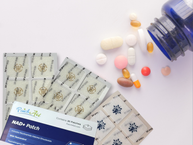Look out, oral vitamins. Your time is up. Move over for vitamin patches because vitamin patches are more than just a novelty. Isn’t it time you get up to speed on vitamin patches? Here is what you should know about the science of vitamin patches, or transdermal patches, as well as how they compare to oral vitamins.
What Are Transdermal Vitamins?
Transdermal vitamins are just another way of saying vitamins that you take across your skin using a topical patch. That is, you apply a patch to your skin to get your vitamins instead of swallowing a capsule, chewable, liquid, or gummy to get your vitamins.
PatchAid Vitamin Patches are made with the active ingredients suspended in a matrix. For Vitamin D3 Patches by PatchAid, those active ingredients are vitamin D3, calcium, magnesium, and vitamin K. In oral vitamins, the active ingredients are in the capsule or other form.
How Transdermal Vitamins Work versus Oral Supplements
When you take an oral supplement, the nutrients go into your digestive tract just like they do when you eat food. When you use topical patches, the nutrients in the patch are activated when they touch your skin. They go across your skin into your bloodstream.
Taking Transdermal Vitamins Compared to Oral Supplements
Taking oral supplements can be a hassle. It is a bit of a process to swallow capsules, especially large ones or ones that are not coated. Take too long, and you might get some of the unpleasant taste of the capsule in your mouth. Liquids and chewable vitamins usually claim to taste good, but they don’t always. They may taste chalky or unpleasant.
It is easy to use vitamin patches. Just apply a patch to your skin. Then remove it 8 hours later and discard it.
Effectiveness of Transdermal Vitamins versus Oral Supplements
Oral supplements have been used for years and are thought of as highly absorbable, but is that justified? The actual absorption rates of oral supplements may not be as high as you assume. Add to that possibly reduced absorption rates such as due to competition between multiple nutrients in a single vitamin pill, and oral supplements may not be as effective as you thought.
Vitamin D3 Patches by PatchAid are designed to increase absorption.* There is no chance of nutrients competing for absorption from the digestive tract. Plus, vitamin D helps the body use calcium, which is in the patches as well. A peer-reviewed study looked at the effectiveness of vitamin D topical patches. Researchers concluded that patches have the potential to help maintain healthy vitamin D levels in high-risk people.
Research is ongoing, but the trend is for transdermal vitamins to become more mainstream. They are easier to use, they do not lead to gastrointestinal side effects, and they do not cause interference with absorption. Ask your doctor if PatchAid Vitamin Patches, such as a Vitamin D3 patch, may be right for you. It could be the best way to get your vitamins!*
*The Food and Drug Administration has not evaluated these statements. PatchAid patches are not intended to diagnose, treat, cure or prevent any disease. Anyone with a medical condition should seek the advice of a licensed medical practitioner. Individual results may vary.







